C语言函数大全--c开头的函数之复数篇
原创C语言函数大全--c开头的函数之复数篇
原创

总览
函数声明 | 函数功能 |
|---|---|
| 计算复数 z 的绝对值(double) |
| 计算复数 z 的绝对值(float) |
| 计算复数 z 的绝对值(long double) |
| 计算复数z的实部(double) |
| 计算复数z的实部(float) |
| 计算复数z的实部(long double) |
| 计算复数z的虚部(double) |
| 计算复数z的虚部(float) |
| 计算复数z的虚部(long double) |
| 计算复数z的相位角 (double) |
| 计算复数z的相位角(float) |
| 计算复数z的相位角(long double) |
| 计算复数z的反余弦 (double complex) |
| 计算复数z的反余弦(float complex) |
| 计算复数z的反余弦(long double complex) |
| 计算复数z的反双曲余弦(double complex) |
| 计算复数z的反双曲余弦(float complex) |
| 计算复数z的反双曲余弦(long double complex) |
| 计算复数z的反正弦(double complex) |
| 计算复数z的反正弦(float complex) |
| 计算复数z的反正弦(long double complex) |
| 计算复数z的反双曲正弦(double complex) |
| 计算复数z的反双曲正弦(float complex) |
| 计算复数z的反双曲正弦(long double complex) |
| 计算复数z的反正切(double complex) |
| 计算复数z的反正切(float complex) |
| 计算复数z的反正切(long double complex) |
| 计算复数z的反双曲正切(double complex) |
| 计算复数z的反双曲正切(float complex) |
| 计算复数z的反双曲正切(long double complex) |
| 计算复数z的余弦(double complex) |
| 计算复数z的余弦(float complex) |
| 计算复数z的余弦(long double complex) |
| 计算复数z的双曲余弦(double complex) |
| 计算复数z的双曲余弦(float complex) |
| 计算复数z的双曲余弦(long double complex) |
| 计算复数z的正弦(double complex) |
| 计算复数z的正弦(float complex) |
| 计算复数z的正弦(long double complex) |
| 计算复数z的双曲正弦(double complex) |
| 计算复数z的双曲正弦(float complex) |
| 计算复数z的双曲正弦(long double complex) |
| 计算复数z的正切(double complex) |
| 计算复数z的正切(float complex) |
| 计算复数z的正切(long double complex) |
| 计算复数z的双曲正切(double complex) |
| 计算复数z的双曲正切(float complex) |
| 计算复数z的双曲正切(long double complex) |
| 计算复数z的指数基数e(double complex) |
| 计算复数z的指数基数e(float complex) |
| 计算复数z的指数基数e(long double complex) |
| 计算复数z的自然对数(以e为底)(double complex) |
| 计算复数z的自然对数(以e为底)(float complex) |
| 计算复数z的自然对数(以e为底)(long double complex) |
| 计算复数z的共轭(double complex) |
| 计算复数z的共轭(float complex) |
| 计算复数z的共轭(long double complex) |
| 计算x的y次方值 (double complex) |
| 计算x的y次方值 (float complex) |
| 计算x的y次方值 (double complex) |
| 计算复数z在黎曼球面上的投影(double complex) |
| 计算复数z在黎曼球面上的投影(float complex) |
| 计算复数z在黎曼球面上的投影(long double complex) |
| 计算复数z的平方根(double complex) |
| 计算复数z的平方根(float complex) |
| 计算复数z的平方根(long double complex) |
1. cabs,cabsf,cabsl
1.1 函数说明
函数声明 | 函数功能 |
|---|---|
| 计算复数 z 的绝对值(double) |
| 计算复数 z 的绝对值(float) |
| 计算复数 z 的绝对值(long double) |
1.2 演示示例
// Huazie
#include <stdio.h>
#include <complex.h>
int main(void)
{
double complex z;
double x = 2.0, y = 2.0, val;
z = x + y * I; // I 代指 虚数单位 i
val = cabs(z); // 计算复数 z 的绝对值
float complex zf;
float xf = 2.0, yf = 2.0, valf;
zf = xf + yf * I;
valf = cabsf(zf);
long double complex zL;
long double xL = 2.0, yL = 2.0, valL;
zL = xL + yL * I;
valL = cabsl(zL);
printf("The absolute value of (%.4lf + %.4lfi) is %.20lf\n", x, y, val);
printf("The absolute value of (%.4f + %.4fi) is %.20f\n", xf, yf, valf);
printf("The absolute value of (%.4Lf + %.4Lfi) is %.20Lf", xL, yL, valL);
return 0;
}1.3 运行结果
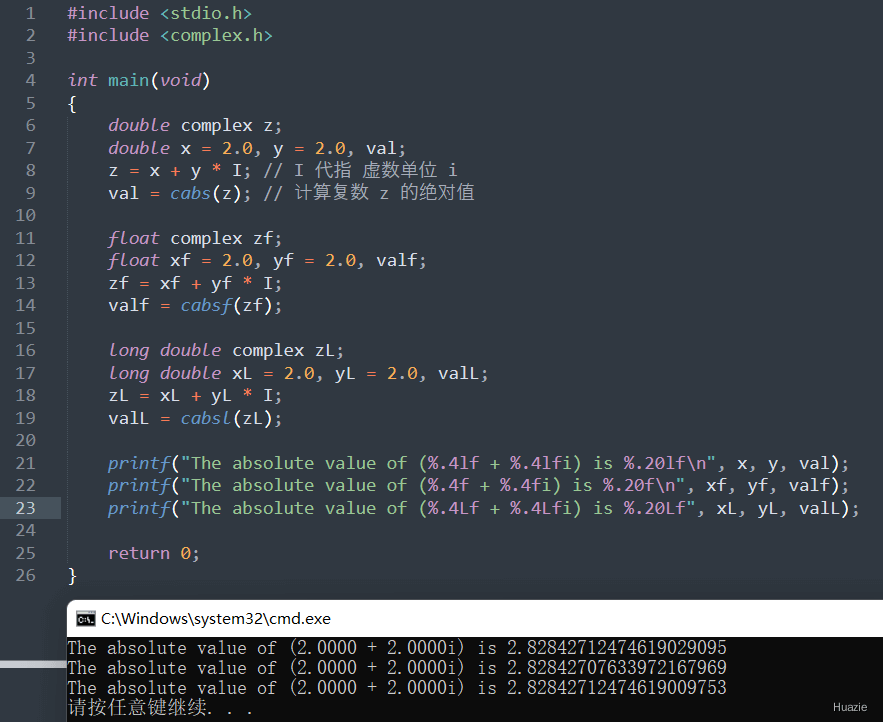
2. creal,crealf,creall
2.1 函数说明
函数声明 | 函数功能 |
|---|---|
| 计算复数z的实部(double) |
| 计算复数z的实部(float) |
| 计算复数z的实部(long double) |
2.2 演示示例
// Huazie
#include <stdio.h>
#include <complex.h>
int main(void)
{
double complex z;
double x = 2.0, y = 1.0;
z = x + y * I; // I 代指 虚数单位 i
float complex zf;
float xf = 3.0, yf = 1.0;
zf = xf + yf * I;
long double complex zL;
long double xL = 4.0, yL = 1.0;
zL = xL + yL * I;
printf("The real part of (%.4lf + %.4lfi) is %.4lf\n", x, y, creal(z));
printf("The real part of (%.4f + %.4fi) is %.4f\n", xf, yf, crealf(zf));
printf("The real part of (%.4Lf + %.4Lfi) is %.4Lf", xL, yL, creall(zL));
return 0;
}2.3 运行结果
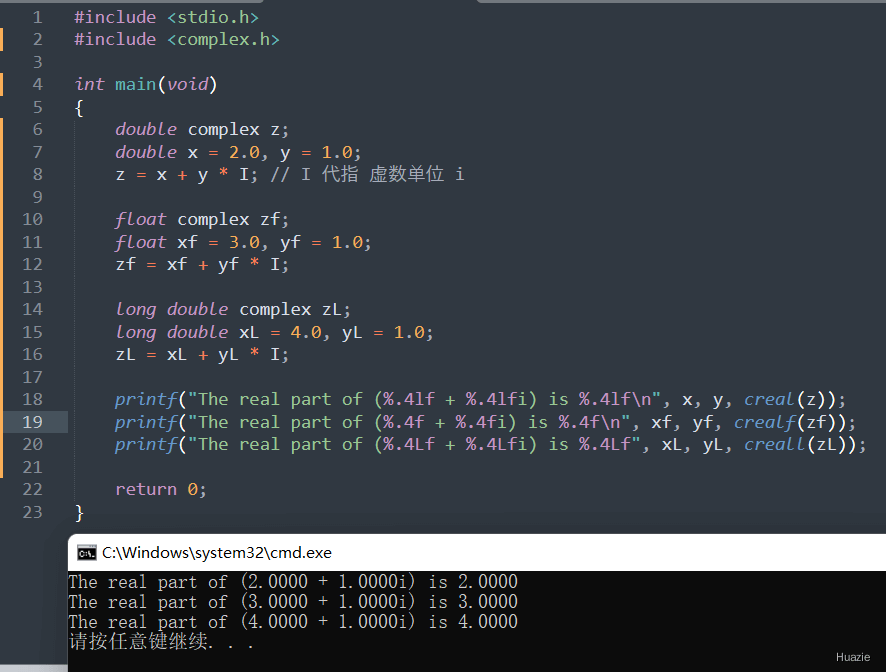
3. cimag,cimagf,cimagl
3.1 函数说明
函数声明 | 函数功能 |
|---|---|
| 计算复数z的虚部(double) |
| 计算复数z的虚部(float) |
| 计算复数z的虚部(long double) |
3.2 演示示例
// Huazie
#include <stdio.h>
#include <complex.h>
int main(void)
{
double complex z;
double x = 1.0, y = 2.0;
z = x + y * I; // I 代指 虚数单位 i
float complex zf;
float xf = 1.0, yf = 3.0;
zf = xf + yf * I;
long double complex zL;
long double xL = 1.0, yL = 4.0;
zL = xL + yL * I;
printf("The imaginary part of (%.4lf + %.4lfi) is %.4lf\n", x, y, cimag(z));
printf("The imaginary part of (%.4f + %.4fi) is %.4f\n", xf, yf, cimagf(zf));
printf("The imaginary part of (%.4Lf + %.4Lfi) is %.4Lf", xL, yL, cimagl(zL));
return 0;
}3.3 运行结果

4. carg,cargf,cargl
4.1 函数说明
函数声明 | 函数功能 |
|---|---|
| 计算复数z的相位角 (double) |
| 计算复数z的相位角(float) |
| 计算复数z的相位角(long double) |
相位角是描述波形在时间轴上的位置的一个重要参数,它决定了波形的起始位置和变化状态。在实际应用中,相位角的测量和控制对于电路设计和信号处理至关重要。通过对相位角的理解和应用,可以更好地分析和控制波动现象,从而实现对电力系统和通信系统的优化。
4.2 演示示例
#include <stdio.h>
#include <complex.h>
int main(void)
{
double complex z;
z = 1.0 + 2.0 * I; // I 代指 虚数单位 i
float complex zf;
zf = 1.0f + 2.0f * I;
long double complex zL;
zL = (long double) 1.0 + (long double) 2.0 * I;
printf("The phase angle of (%.4lf + %.4lfi) is %.60lf\n", creal(z), cimag(z), carg(z));
printf("The phase angle of (%.4f + %.4fi) is %.60f\n", crealf(zf), cimagf(zf), cargf(zf));
printf("The phase angle of (%.4Lf + %.4Lfi) is %.60Lf", creall(zL), cimagl(zL), cargl(zL));
return 0;
}4.3 运行结果
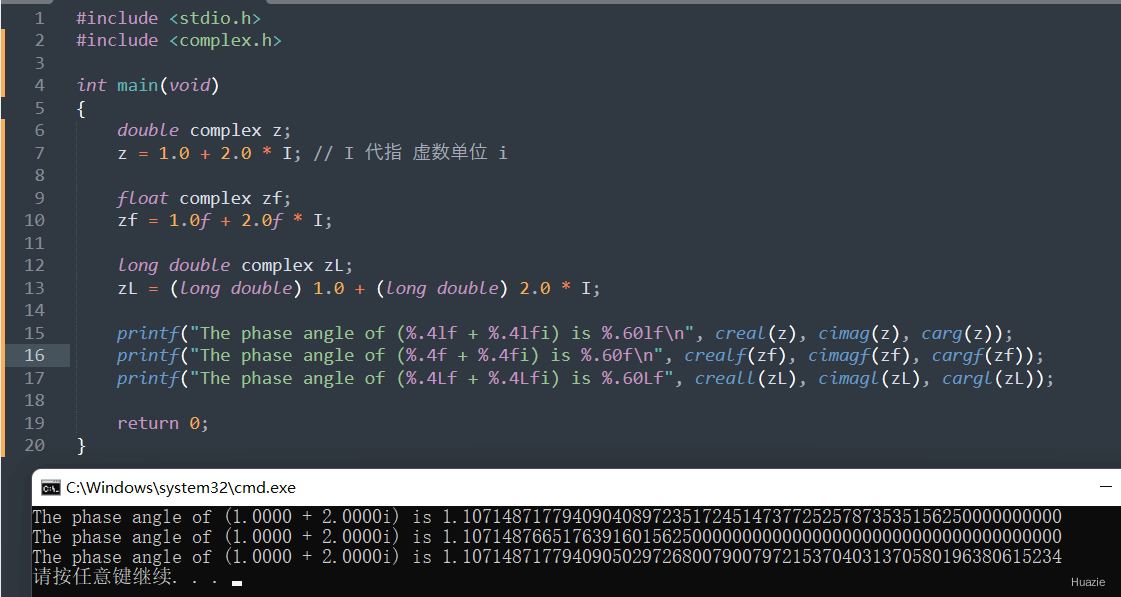
5. cacos,cacosf,cacosl
5.1 函数说明
函数声明 | 函数功能 |
|---|---|
| 计算复数z的反余弦 (double complex) |
| 计算复数z的反余弦(float complex) |
| 计算复数z的反余弦(long double complex) |
反余弦函数是三角函数中余弦函数的逆函数,其主要作用是在已知余弦函数值的情况下,求解对应的角度值。反余弦函数的定义域为[-1, 1],值域为[0, π]。
反余弦函数的图像是一个在[0, π]区间内单调递减的曲线。
- 当
x=1时,arccos(1)=0,表示余弦值为1的角度是0度; - 当
x=-1时,arccos(-1)=π,表示余弦值为-1的角度是180度。 - 随着x值从1减小到-1,
arccos(x)的值从0增加到π。
5.2 演示示例
#include <stdio.h>
#include <math.h>
#include <complex.h>
int main(void)
{
double complex z, zcacos;
z = 1.0 + 2.0 * I; // I 代指 虚数单位 i
zcacos = cacos(z); // 计算复数z的反余弦
float complex zf, zcacosf;
zf = 1.0f + 2.0f * I;
zcacosf = cacosf(zf);
long double complex zL, zcacosl;
zL = (long double) 1.0 + (long double) 2.0 * I;
zcacosl = cacosl(zL);
double zimag = cimag(zcacos);
float zimagf = cimagf(zcacosf);
long double zimagl = cimagl(zcacosl);
if (zimag < 0)
printf("The arc cosine of (%.4lf + %.4lfi) is (%.20lf - %.20lfi)\n", creal(z), cimag(z), creal(zcacos), fabs(zimag));
else
printf("The arc cosine of (%.4lf + %.4lfi) is (%.20lf + %.20lfi)\n", creal(z), cimag(z), creal(zcacos), zimag);
if (zimagf < 0)
printf("The arc cosine of (%.4f + %.4fi) is (%.20f - %.20fi)\n", crealf(zf), cimagf(zf), crealf(zcacosf), fabsf(zimagf));
else
printf("The arc cosine of (%.4f + %.4fi) is (%.20f + %.20fi)\n", crealf(zf), cimagf(zf), crealf(zcacosf), zimagf);
if (zimagl < 0)
printf("The arc cosine of (%.4Lf + %.4Lfi) is (%.20Lf - %.20Lfi)", creall(zL), cimagl(zL), creall(zcacosl), fabsl(zimagl));
else
printf("The arc cosine of (%.4Lf + %.4Lfi) is (%.20Lf + %.20Lfi)", creall(zL), cimagl(zL), creall(zcacosl), zimagl);
return 0;
}5.3 运行结果

6. cacosh,cacoshf,cacoshl
6.1 函数说明
函数声明 | 函数功能 |
|---|---|
| 计算复数z的反双曲余弦(double complex) |
| 计算复数z的反双曲余弦(float complex) |
| 计算复数z的反双曲余弦(long double complex) |
反双曲余弦函数,表示为双曲余弦函数的反函数,其定义为:对于任意实数x(x≥1),存在一个唯一的实数y,使得cosh(y) = x。此时,y就被称为x的反双曲余弦值。
6.2 演示示例
#include <stdio.h>
#include <math.h>
#include <complex.h>
int main(void)
{
double complex z, zcacosh;
z = 1.0 + 2.0 * I; // I 代指 虚数单位 i
zcacosh = cacosh(z); // 反双曲余弦
float complex zf, zcacoshf;
zf = 1.0f + 2.0f * I;
zcacoshf = cacoshf(zf);
long double complex zL, zcacoshl;
zL = (long double) 1.0 + (long double) 2.0 * I;
zcacoshl = cacoshl(zL);
double zimag = cimag(zcacosh);
float zimagf = cimagf(zcacoshf);
long double zimagl = cimagl(zcacoshl);
if (zimag < 0)
printf("The inverse hyperbolic cosine of (%.4lf + %.4lfi) is (%.20lf - %.20lfi)\n", creal(z), cimag(z), creal(zcacosh), fabs(zimag));
else
printf("The inverse hyperbolic cosine of (%.4lf + %.4lfi) is (%.20lf + %.20lfi)\n", creal(z), cimag(z), creal(zcacosh), zimag);
if (zimagf < 0)
printf("The inverse hyperbolic cosine of (%.4f + %.4fi) is (%.20f - %.20fi)\n", crealf(zf), cimagf(zf), crealf(zcacoshf), fabsf(zimagf));
else
printf("The inverse hyperbolic cosine of (%.4f + %.4fi) is (%.20f + %.20fi)\n", crealf(zf), cimagf(zf), crealf(zcacoshf), zimagf);
if (zimagl < 0)
printf("The inverse hyperbolic cosine of (%.4Lf + %.4Lfi) is (%.20Lf - %.20Lfi)", creall(zL), cimagl(zL), creall(zcacoshl), fabsl(zimagl));
else
printf("The inverse hyperbolic cosine of (%.4Lf + %.4Lfi) is (%.20Lf + %.20Lfi)", creall(zL), cimagl(zL), creall(zcacoshl), zimagl);
return 0;
}6.3 运行结果

7. casin,casinf,casinl
7.1 函数说明
函数声明 | 函数功能 |
|---|---|
| 计算复数z的反正弦(double complex) |
| 计算复数z的反正弦(float complex) |
| 计算复数z的反正弦(long double complex) |
反正弦函数是正弦函数的反函数。也就是说,如果sinθ=x,且x在[-1,1]的范围内,那么θ就是x的反正弦值。
7.2 演示示例
#include <stdio.h>
#include <math.h>
#include <complex.h>
int main(void)
{
double complex z, zcasin;
z = 1.0 + 2.0 * I; // I 代指 虚数单位 i
zcasin = casin(z); // 反正弦
float complex zf, zcasinf;
zf = 1.0f + 2.0f * I;
zcasinf = casinf(zf);
long double complex zL, zcasinl;
zL = (long double) 1.0 + (long double) 2.0 * I;
zcasinl = casinl(zL);
double zimag = cimag(zcasin);
float zimagf = cimagf(zcasinf);
long double zimagl = cimagl(zcasinl);
if (zimag < 0)
printf("The arcsine of (%.4lf + %.4lfi) is (%.20lf - %.20lfi)\n", creal(z), cimag(z), creal(zcasin), fabs(zimag));
else
printf("The arcsine of (%.4lf + %.4lfi) is (%.20lf + %.20lfi)\n", creal(z), cimag(z), creal(zcasin), zimag);
if (zimagf < 0)
printf("The arcsine of (%.4f + %.4fi) is (%.20f - %.20fi)\n", crealf(zf), cimagf(zf), crealf(zcasinf), fabsf(zimagf));
else
printf("The arcsine of (%.4f + %.4fi) is (%.20f + %.20fi)\n", crealf(zf), cimagf(zf), crealf(zcasinf), zimagf);
if (zimagl < 0)
printf("The arcsine of (%.4Lf + %.4Lfi) is (%.20Lf - %.20Lfi)", creall(zL), cimagl(zL), creall(zcasinl), fabsl(zimagl));
else
printf("The arcsine of (%.4Lf + %.4Lfi) is (%.20Lf + %.20Lfi)", creall(zL), cimagl(zL), creall(zcasinl), zimagl);
return 0;
}7.3 运行结果
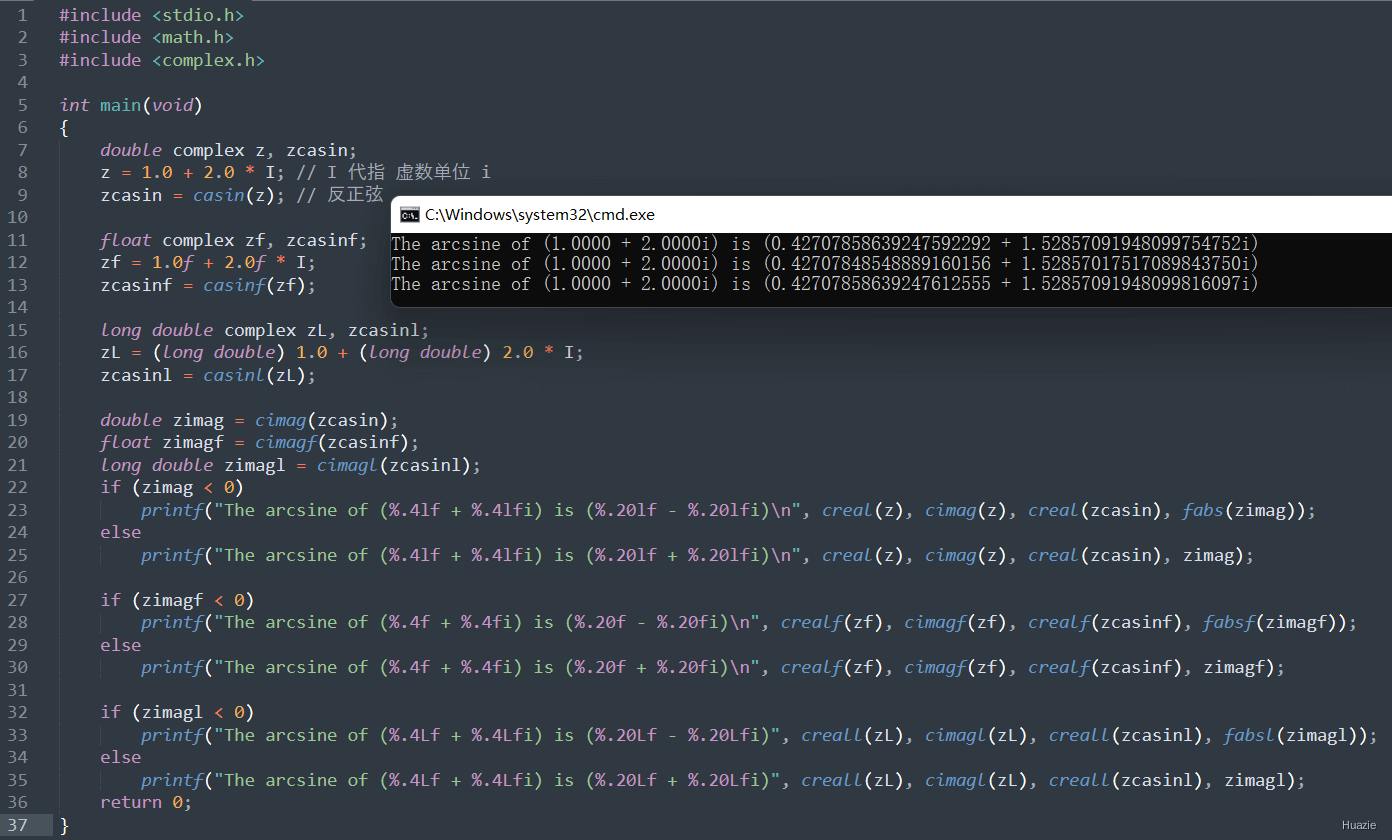
8. casinh,casinhf,casinhl
8.1 函数说明
函数声明 | 函数功能 |
|---|---|
| 计算复数z的反双曲正弦(double complex) |
| 计算复数z的反双曲正弦(float complex) |
| 计算复数z的反双曲正弦(long double complex) |
反双曲正弦函数是双曲正弦函数的反函数。
8.2 演示示例
#include <stdio.h>
#include <math.h>
#include <complex.h>
int main(void)
{
double complex z, zcasinh;
z = 1.0 + 2.0 * I; // I 代指 虚数单位 i
zcasinh = casinh(z); // 反双曲正弦
float complex zf, zcasinhf;
zf = 1.0f + 2.0f * I;
zcasinhf = casinhf(zf);
long double complex zL, zcasinhl;
zL = (long double) 1.0 + (long double) 2.0 * I;
zcasinhl = casinhl(zL);
double zimag = cimag(zcasinh);
float zimagf = cimagf(zcasinhf);
long double zimagl = cimagl(zcasinhl);
if (zimag < 0)
printf("The inverse hyperbolic sine of (%.4lf + %.4lfi) is (%.20lf - %.20lfi)\n", creal(z), cimag(z), creal(zcasinh), fabs(zimag));
else
printf("The inverse hyperbolic sine of (%.4lf + %.4lfi) is (%.20lf + %.20lfi)\n", creal(z), cimag(z), creal(zcasinh), zimag);
if (zimagf < 0)
printf("The inverse hyperbolic sine of (%.4f + %.4fi) is (%.20f - %.20fi)\n", crealf(zf), cimagf(zf), crealf(zcasinhf), fabsf(zimagf));
else
printf("The inverse hyperbolic sine of (%.4f + %.4fi) is (%.20f + %.20fi)\n", crealf(zf), cimagf(zf), crealf(zcasinhf), zimagf);
if (zimagl < 0)
printf("The inverse hyperbolic sine of (%.4Lf + %.4Lfi) is (%.20Lf - %.20Lfi)", creall(zL), cimagl(zL), creall(zcasinhl), fabsl(zimagl));
else
printf("The inverse hyperbolic sine of (%.4Lf + %.4Lfi) is (%.20Lf + %.20Lfi)", creall(zL), cimagl(zL), creall(zcasinhl), zimagl);
return 0;
}8.3 运行结果
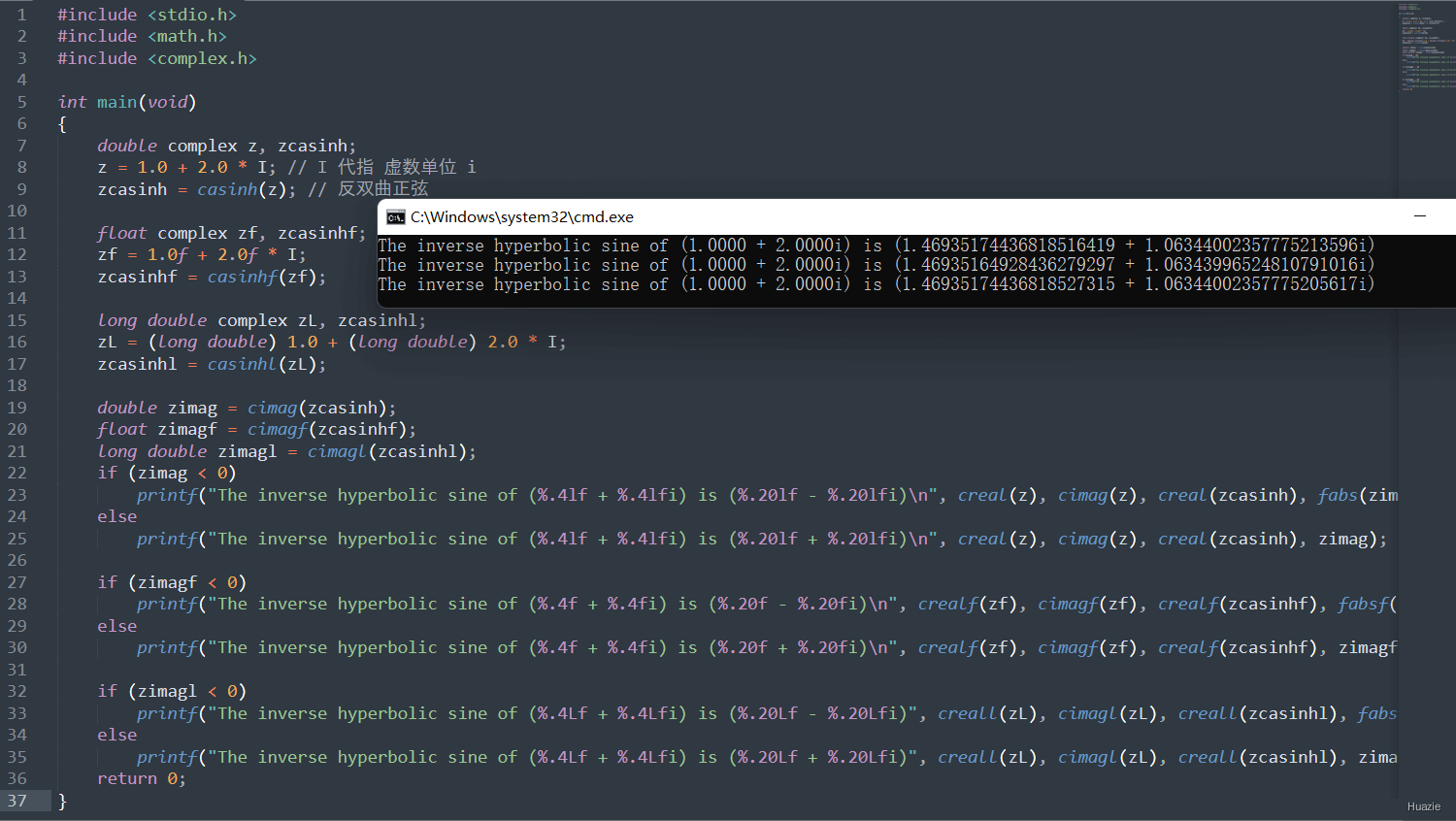
9. catan,catanf,catanl
9.1 函数说明
函数声明 | 函数功能 |
|---|---|
| 计算复数z的反正切(double complex) |
| 计算复数z的反正切(float complex) |
| 计算复数z的反正切(long double complex) |
反正切函数是正切函数的反函数。如果给定一个正切值x,反正切函数会返回对应的角度值θ,该角度值θ满足tan(θ)=x,并且θ在(-π/2, π/2)范围内。
9.2 演示示例
#include <stdio.h>
#include <math.h>
#include <complex.h>
int main(void)
{
double complex z, zcatan;
z = 1.0 + 2.0 * I; // I 代指 虚数单位 i
zcatan = catan(z); // 反正切
float complex zf, zcatanf;
zf = 1.0f + 2.0f * I;
zcatanf = catanf(zf);
long double complex zL, zcatanl;
zL = (long double) 1.0 + (long double) 2.0 * I;
zcatanl = catanl(zL);
double zimag = cimag(zcatan);
float zimagf = cimagf(zcatanf);
long double zimagl = cimagl(zcatanl);
if (zimag < 0)
printf("The arc tangent of (%.4lf + %.4lfi) is (%.20lf - %.20lfi)\n", creal(z), cimag(z), creal(zcatan), fabs(zimag));
else
printf("The arc tangent of (%.4lf + %.4lfi) is (%.20lf + %.20lfi)\n", creal(z), cimag(z), creal(zcatan), zimag);
if (zimagf < 0)
printf("The arc tangent of (%.4f + %.4fi) is (%.20f - %.20fi)\n", crealf(zf), cimagf(zf), crealf(zcatanf), fabsf(zimagf));
else
printf("The arc tangent of (%.4f + %.4fi) is (%.20f + %.20fi)\n", crealf(zf), cimagf(zf), crealf(zcatanf), zimagf);
if (zimagl < 0)
printf("The arc tangent of (%.4Lf + %.4Lfi) is (%.20Lf - %.20Lfi)", creall(zL), cimagl(zL), creall(zcatanl), fabsl(zimagl));
else
printf("The arc tangent of (%.4Lf + %.4Lfi) is (%.20Lf + %.20Lfi)", creall(zL), cimagl(zL), creall(zcatanl), zimagl);
return 0;
}9.3 运行结果

10. catanh,catanhf,catanhl
10.1 函数说明
函数声明 | 函数功能 |
|---|---|
| 计算复数z的反双曲正切(double complex) |
| 计算复数z的反双曲正切(float complex) |
| 计算复数z的反双曲正切(long double complex) |
反双曲正切函数是双曲正切函数的反函数。
10.2 演示示例
#include <stdio.h>
#include <math.h>
#include <complex.h>
int main(void)
{
double complex z, zcatanh;
z = 1.0 + 2.0 * I; // I 代指 虚数单位 i
zcatanh = catanh(z); // 反双曲正切
float complex zf, zcatanhf;
zf = 1.0f + 2.0f * I;
zcatanhf = catanhf(zf);
long double complex zL, zcatanhl;
zL = (long double) 1.0 + (long double) 2.0 * I;
zcatanhl = catanhl(zL);
double zimag = cimag(zcatanh);
float zimagf = cimagf(zcatanhf);
long double zimagl = cimagl(zcatanhl);
if (zimag < 0)
printf("The inverse hyperbolic tangent of (%.4lf + %.4lfi) is (%.20lf - %.20lfi)\n", creal(z), cimag(z), creal(zcatanh), fabs(zimag));
else
printf("The inverse hyperbolic tangent of (%.4lf + %.4lfi) is (%.20lf + %.20lfi)\n", creal(z), cimag(z), creal(zcatanh), zimag);
if (zimagf < 0)
printf("The inverse hyperbolic tangent of (%.4f + %.4fi) is (%.20f - %.20fi)\n", crealf(zf), cimagf(zf), crealf(zcatanhf), fabsf(zimagf));
else
printf("The inverse hyperbolic tangent of (%.4f + %.4fi) is (%.20f + %.20fi)\n", crealf(zf), cimagf(zf), crealf(zcatanhf), zimagf);
if (zimagl < 0)
printf("The inverse hyperbolic tangent of (%.4Lf + %.4Lfi) is (%.20Lf - %.20Lfi)", creall(zL), cimagl(zL), creall(zcatanhl), fabsl(zimagl));
else
printf("The inverse hyperbolic tangent of (%.4Lf + %.4Lfi) is (%.20Lf + %.20Lfi)", creall(zL), cimagl(zL), creall(zcatanhl), zimagl);
return 0;
}10.3 运行结果
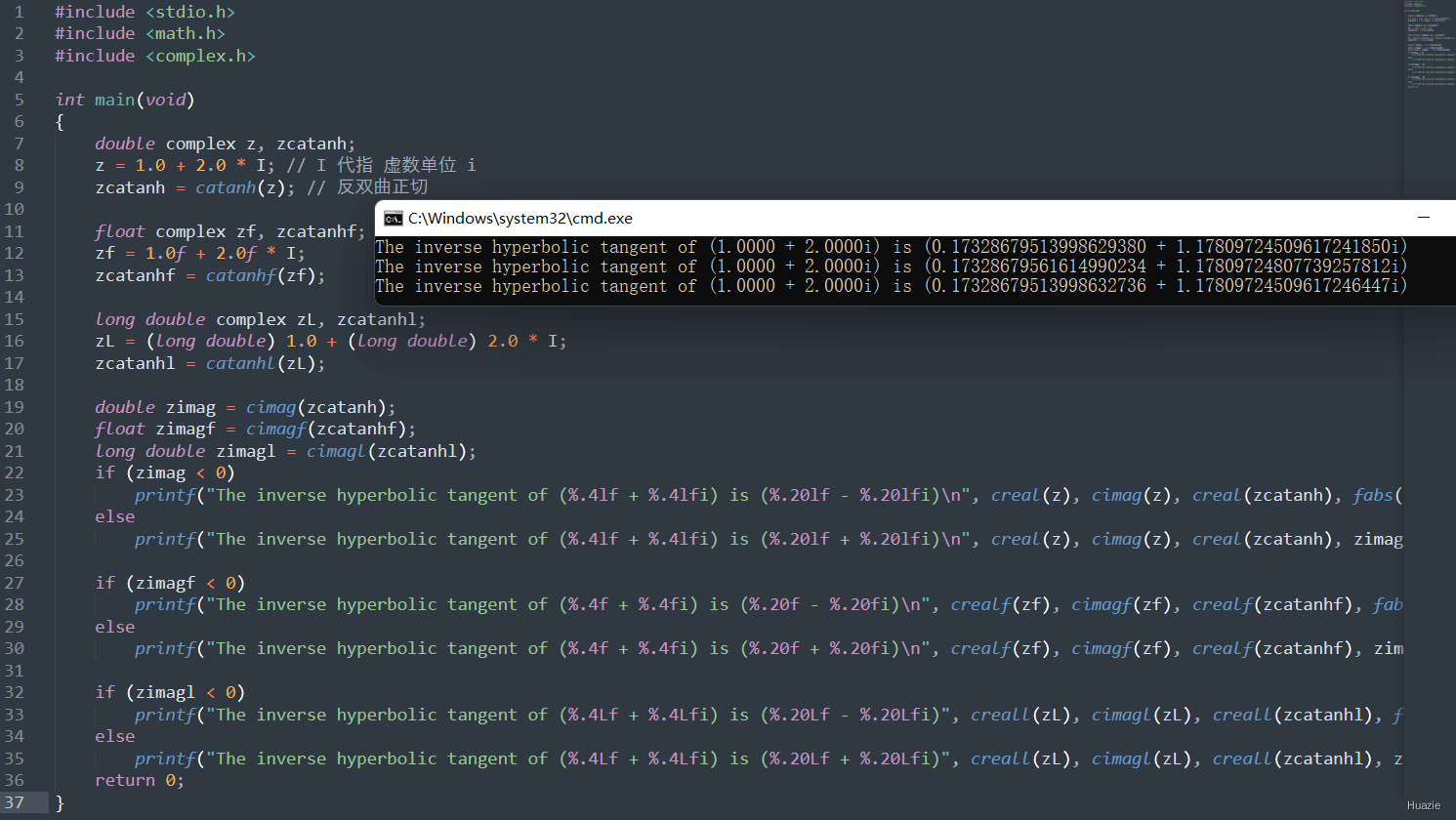
11. ccos,ccosf,ccosl
11.1 函数说明
函数声明 | 函数功能 |
|---|---|
| 计算复数z的余弦(double complex) |
| 计算复数z的余弦(float complex) |
| 计算复数z的余弦(long double complex) |
11.2 演示示例
#include <stdio.h>
#include <math.h>
#include <complex.h>
int main(void)
{
double complex z, zccos;
z = 1.0 + 2.0 * I; // I 代指 虚数单位 i
zccos = ccos(z); // 余弦
float complex zf, zccosf;
zf = 1.0f + 2.0f * I;
zccosf = ccosf(zf);
long double complex zL, zccosl;
zL = (long double) 1.0 + (long double) 2.0 * I;
zccosl = ccosl(zL);
double zimag = cimag(zccos);
float zimagf = cimagf(zccosf);
long double zimagl = cimagl(zccosl);
if (zimag < 0)
printf("The cosine of (%.4lf + %.4lfi) is (%.20lf - %.20lfi)\n", creal(z), cimag(z), creal(zccos), fabs(zimag));
else
printf("The cosine of (%.4lf + %.4lfi) is (%.20lf + %.20lfi)\n", creal(z), cimag(z), creal(zccos), zimag);
if (zimagf < 0)
printf("The cosine of (%.4f + %.4fi) is (%.20f - %.20fi)\n", crealf(zf), cimagf(zf), crealf(zccosf), fabsf(zimagf));
else
printf("The cosine of (%.4f + %.4fi) is (%.20f + %.20fi)\n", crealf(zf), cimagf(zf), crealf(zccosf), zimagf);
if (zimagl < 0)
printf("The cosine of (%.4Lf + %.4Lfi) is (%.20Lf - %.20Lfi)", creall(zL), cimagl(zL), creall(zccosl), fabsl(zimagl));
else
printf("The cosine of (%.4Lf + %.4Lfi) is (%.20Lf + %.20Lfi)", creall(zL), cimagl(zL), creall(zccosl), zimagl);
return 0;
}11.3 运行结果
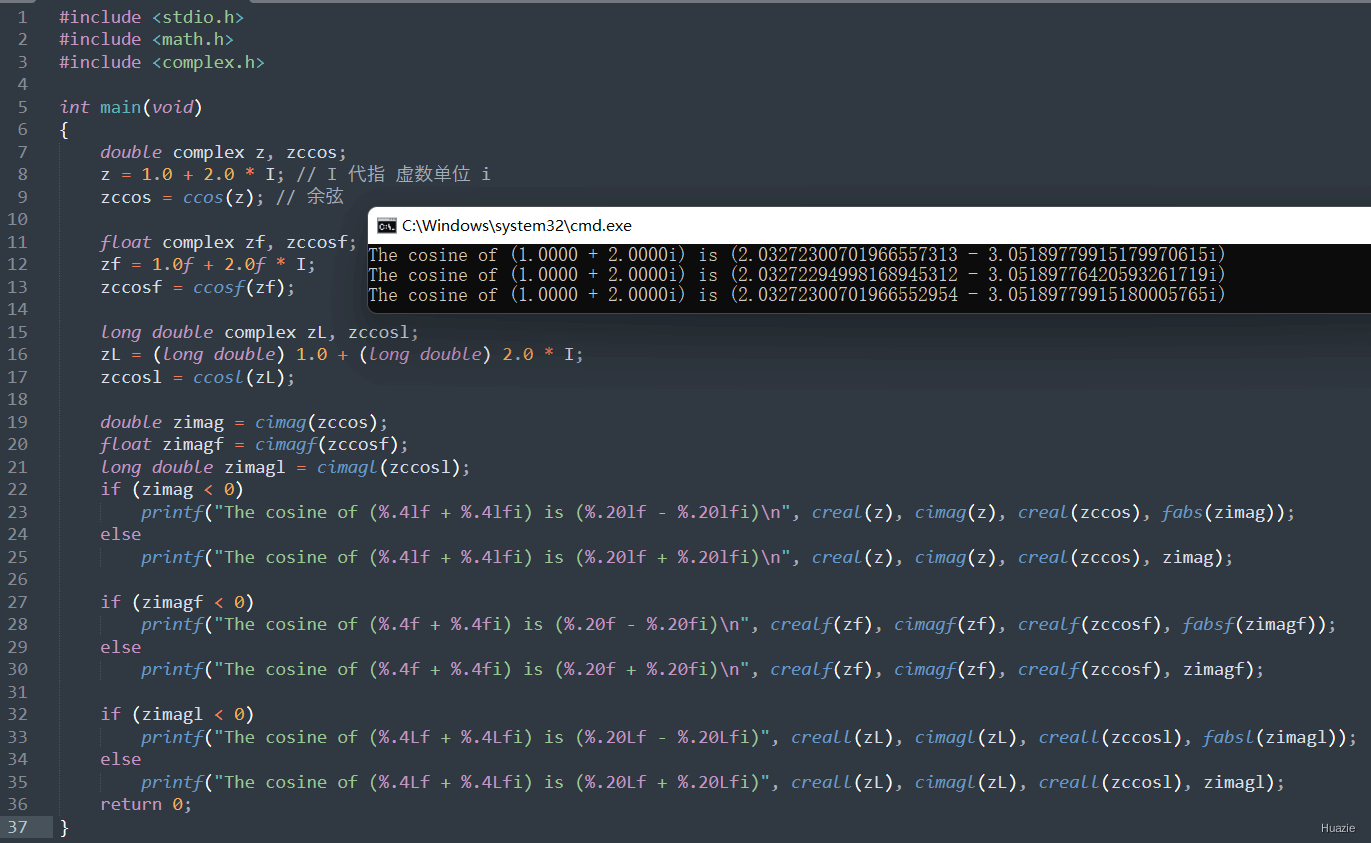
12. ccosh,ccoshf,ccoshl
12.1 函数说明
函数声明 | 函数功能 |
|---|---|
| 计算复数z的双曲余弦(double complex) |
| 计算复数z的双曲余弦(float complex) |
| 计算复数z的双曲余弦(long double complex) |
12.2 演示示例
#include <stdio.h>
#include <math.h>
#include <complex.h>
int main(void)
{
double complex z, zccosh;
z = 1.0 + 2.0 * I; // I 代指 虚数单位 i
zccosh = ccosh(z); // 双曲余弦
float complex zf, zccoshf;
zf = 1.0f + 2.0f * I;
zccoshf = ccoshf(zf);
long double complex zL, zccoshl;
zL = (long double) 1.0 + (long double) 2.0 * I;
zccoshl = ccoshl(zL);
double zimag = cimag(zccosh);
float zimagf = cimagf(zccoshf);
long double zimagl = cimagl(zccoshl);
if (zimag < 0)
printf("The hyperbolic cosine of (%.4lf + %.4lfi) is (%.20lf - %.20lfi)\n", creal(z), cimag(z), creal(zccosh), fabs(zimag));
else
printf("The hyperbolic cosine of (%.4lf + %.4lfi) is (%.20lf + %.20lfi)\n", creal(z), cimag(z), creal(zccosh), zimag);
if (zimagf < 0)
printf("The hyperbolic cosine of (%.4f + %.4fi) is (%.20f - %.20fi)\n", crealf(zf), cimagf(zf), crealf(zccoshf), fabsf(zimagf));
else
printf("The hyperbolic cosine of (%.4f + %.4fi) is (%.20f + %.20fi)\n", crealf(zf), cimagf(zf), crealf(zccoshf), zimagf);
if (zimagl < 0)
printf("The hyperbolic cosine of (%.4Lf + %.4Lfi) is (%.20Lf - %.20Lfi)", creall(zL), cimagl(zL), creall(zccoshl), fabsl(zimagl));
else
printf("The hyperbolic cosine of (%.4Lf + %.4Lfi) is (%.20Lf + %.20Lfi)", creall(zL), cimagl(zL), creall(zccoshl), zimagl);
return 0;
}12.3 运行结果
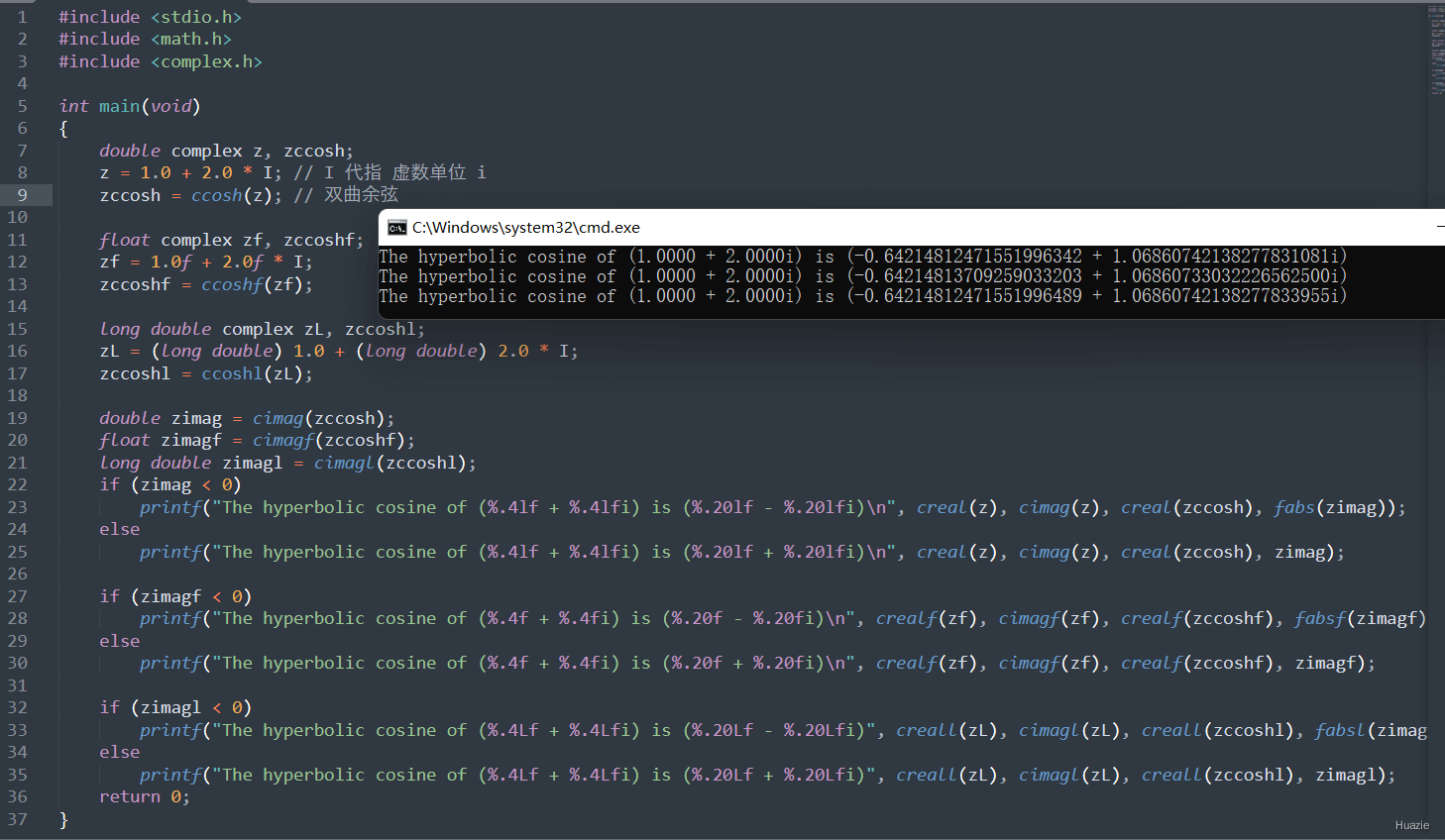
13. csin,csinf,csinl
13.1 函数说明
函数声明 | 函数功能 |
|---|---|
| 计算复数z的正弦(double complex) |
| 计算复数z的正弦(float complex) |
| 计算复数z的正弦(long double complex) |
13.2 演示示例
#include <stdio.h>
#include <math.h>
#include <complex.h>
int main(void)
{
double complex z, zcsin;
z = 1.0 + 2.0 * I; // I 代指 虚数单位 i
zcsin = csin(z); // 正弦
float complex zf, zcsinf;
zf = 1.0f + 2.0f * I;
zcsinf = csinf(zf);
long double complex zL, zcsinl;
zL = (long double) 1.0 + (long double) 2.0 * I;
zcsinl = csinl(zL);
double zimag = cimag(zcsin);
float zimagf = cimagf(zcsinf);
long double zimagl = cimagl(zcsinl);
if (zimag < 0)
printf("The sine of (%.4lf + %.4lfi) is (%.20lf - %.20lfi)\n", creal(z), cimag(z), creal(zcsin), fabs(zimag));
else
printf("The sine of (%.4lf + %.4lfi) is (%.20lf + %.20lfi)\n", creal(z), cimag(z), creal(zcsin), zimag);
if (zimagf < 0)
printf("The sine of (%.4f + %.4fi) is (%.20f - %.20fi)\n", crealf(zf), cimagf(zf), crealf(zcsinf), fabsf(zimagf));
else
printf("The sine of (%.4f + %.4fi) is (%.20f + %.20fi)\n", crealf(zf), cimagf(zf), crealf(zcsinf), zimagf);
if (zimagl < 0)
printf("The sine of (%.4Lf + %.4Lfi) is (%.20Lf - %.20Lfi)", creall(zL), cimagl(zL), creall(zcsinl), fabsl(zimagl));
else
printf("The sine of (%.4Lf + %.4Lfi) is (%.20Lf + %.20Lfi)", creall(zL), cimagl(zL), creall(zcsinl), zimagl);
return 0;
}13.3 运行结果
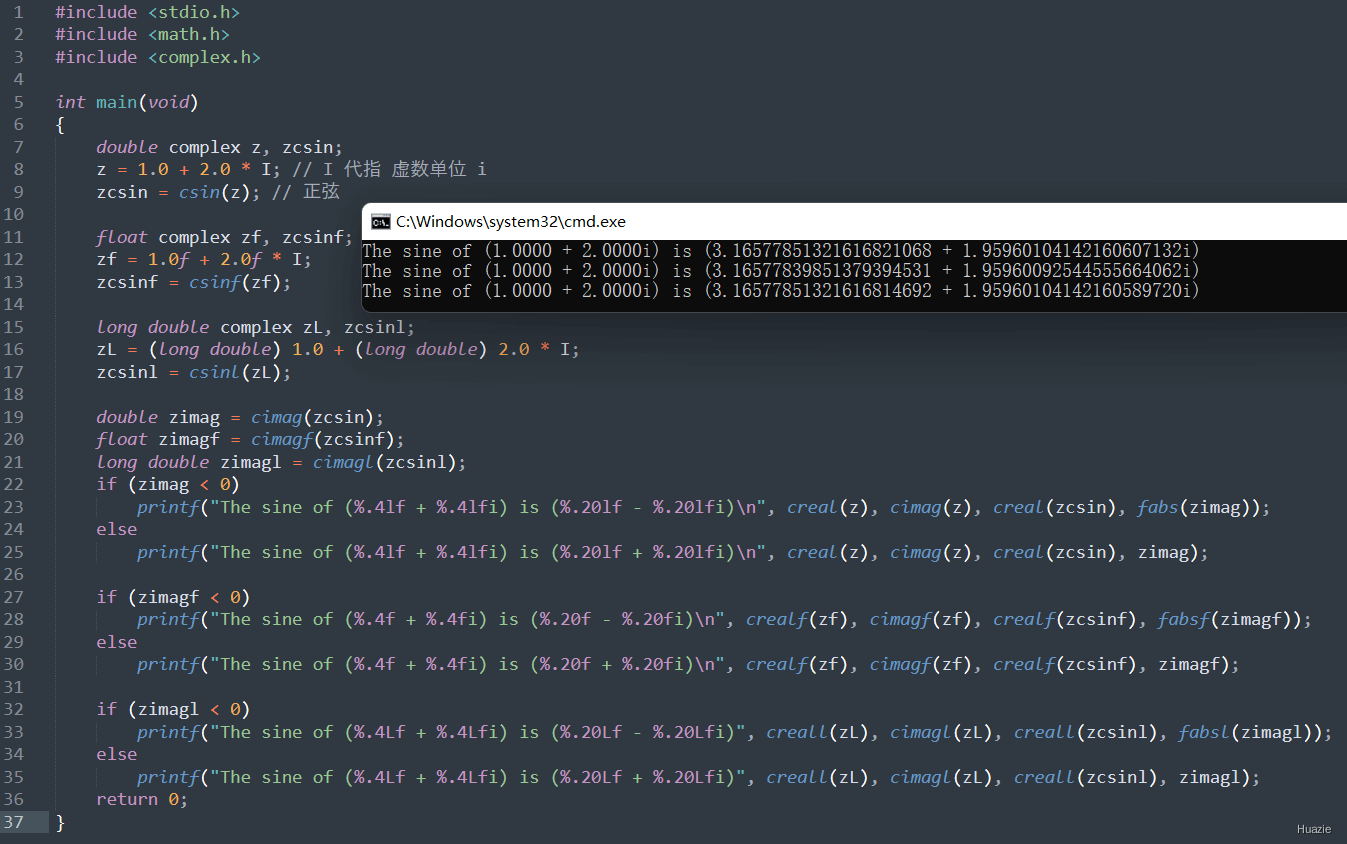
14. csinh,csinhf,csinhl
14.1 函数说明
函数声明 | 函数功能 |
|---|---|
| 计算复数z的双曲正弦(double complex) |
| 计算复数z的双曲正弦(float complex) |
| 计算复数z的双曲正弦(long double complex) |
14.2 演示示例
#include <stdio.h>
#include <math.h>
#include <complex.h>
int main(void)
{
double complex z, zcsinh;
z = 1.0 + 2.0 * I; // I 代指 虚数单位 i
zcsinh = csinh(z); // 双曲正弦
float complex zf, zcsinhf;
zf = 1.0f + 2.0f * I;
zcsinhf = csinhf(zf);
long double complex zL, zcsinhl;
zL = (long double) 1.0 + (long double) 2.0 * I;
zcsinhl = csinhl(zL);
double zimag = cimag(zcsinh);
float zimagf = cimagf(zcsinhf);
long double zimagl = cimagl(zcsinhl);
if (zimag < 0)
printf("The hyperbolic sine of (%.4lf + %.4lfi) is (%.20lf - %.20lfi)\n", creal(z), cimag(z), creal(zcsinh), fabs(zimag));
else
printf("The hyperbolic sine of (%.4lf + %.4lfi) is (%.20lf + %.20lfi)\n", creal(z), cimag(z), creal(zcsinh), zimag);
if (zimagf < 0)
printf("The hyperbolic sine of (%.4f + %.4fi) is (%.20f - %.20fi)\n", crealf(zf), cimagf(zf), crealf(zcsinhf), fabsf(zimagf));
else
printf("The hyperbolic sine of (%.4f + %.4fi) is (%.20f + %.20fi)\n", crealf(zf), cimagf(zf), crealf(zcsinhf), zimagf);
if (zimagl < 0)
printf("The hyperbolic sine of (%.4Lf + %.4Lfi) is (%.20Lf - %.20Lfi)", creall(zL), cimagl(zL), creall(zcsinhl), fabsl(zimagl));
else
printf("The hyperbolic sine of (%.4Lf + %.4Lfi) is (%.20Lf + %.20Lfi)", creall(zL), cimagl(zL), creall(zcsinhl), zimagl);
return 0;
}14.3 运行结果
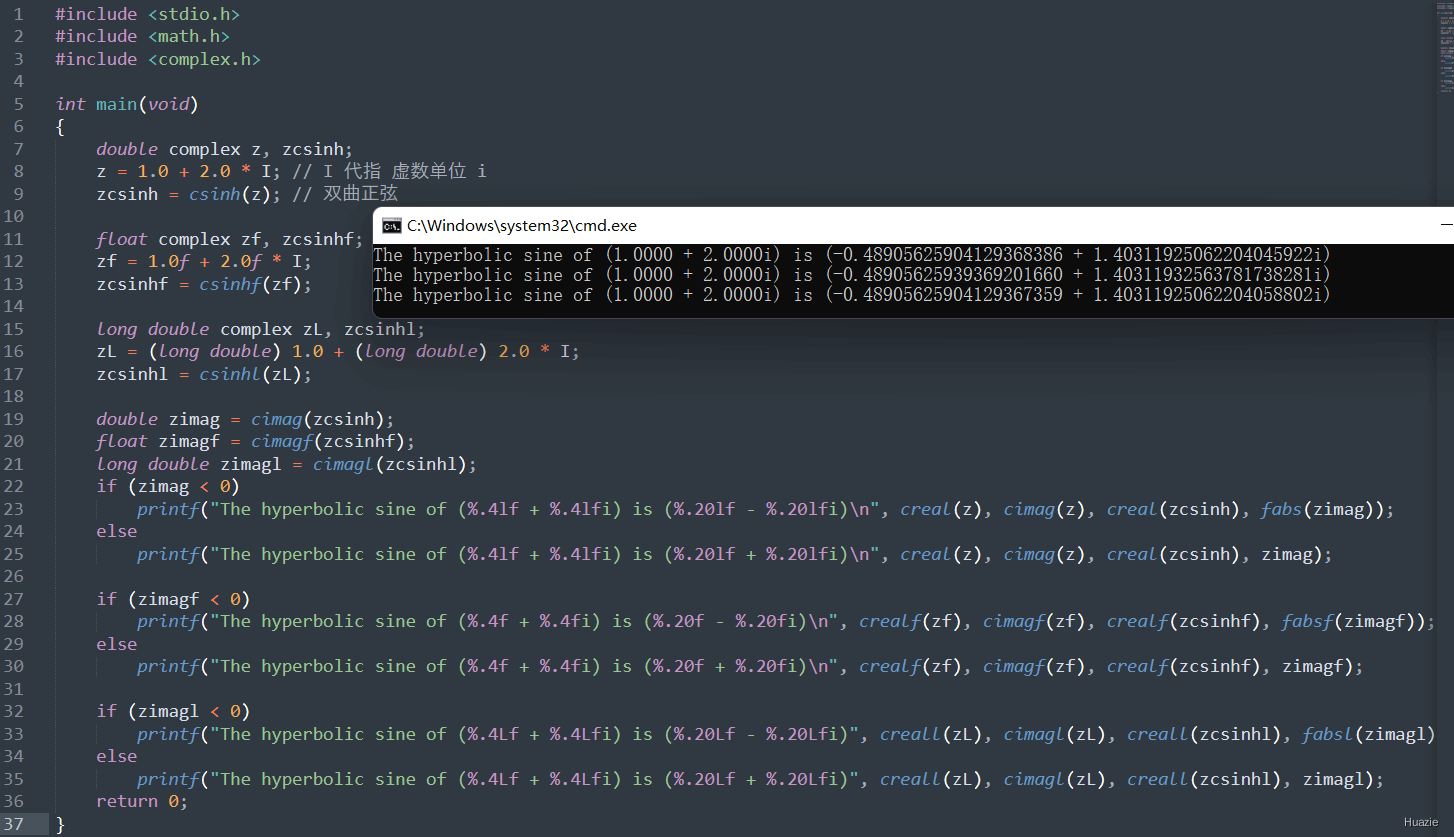
15. ctan,ctanf,ctanl
15.1 函数说明
函数声明 | 函数功能 |
|---|---|
| 计算复数z的正切(double complex) |
| 计算复数z的正切(float complex) |
| 计算复数z的正切(long double complex) |
15.2 演示示例
#include <stdio.h>
#include <math.h>
#include <complex.h>
int main(void)
{
double complex z, zctan;
z = 1.0 + 2.0 * I; // I 代指 虚数单位 i
zctan = ctan(z); // 正切
float complex zf, zctanf;
zf = 1.0f + 2.0f * I;
zctanf = ctanf(zf);
long double complex zL, zctanl;
zL = (long double) 1.0 + (long double) 2.0 * I;
zctanl = ctanl(zL);
double zimag = cimag(zctan);
float zimagf = cimagf(zctanf);
long double zimagl = cimagl(zctanl);
if (zimag < 0)
printf("The tangent of (%.4lf + %.4lfi) is (%.20lf - %.20lfi)\n", creal(z), cimag(z), creal(zctan), fabs(zimag));
else
printf("The tangent of (%.4lf + %.4lfi) is (%.20lf + %.20lfi)\n", creal(z), cimag(z), creal(zctan), zimag);
if (zimagf < 0)
printf("The tangent of (%.4f + %.4fi) is (%.20f - %.20fi)\n", crealf(zf), cimagf(zf), crealf(zctanf), fabsf(zimagf));
else
printf("The tangent of (%.4f + %.4fi) is (%.20f + %.20fi)\n", crealf(zf), cimagf(zf), crealf(zctanf), zimagf);
if (zimagl < 0)
printf("The tangent of (%.4Lf + %.4Lfi) is (%.20Lf - %.20Lfi)", creall(zL), cimagl(zL), creall(zctanl), fabsl(zimagl));
else
printf("The tangent of (%.4Lf + %.4Lfi) is (%.20Lf + %.20Lfi)", creall(zL), cimagl(zL), creall(zctanl), zimagl);
return 0;
}15.3 运行结果

16. ctanh,ctanhf,ctanhl
16.1 函数说明
函数声明 | 函数功能 |
|---|---|
| 计算复数z的双曲正切(double complex) |
| 计算复数z的双曲正切(float complex) |
| 计算复数z的双曲正切(long double complex) |
16.2 演示示例
#include <stdio.h>
#include <math.h>
#include <complex.h>
int main(void)
{
double complex z, zctanh;
z = 1.0 + 2.0 * I; // I 代指 虚数单位 i
zctanh = ctanh(z); // 双曲正切
float complex zf, zctanhf;
zf = 1.0f + 2.0f * I;
zctanhf = ctanhf(zf);
long double complex zL, zctanhl;
zL = (long double) 1.0 + (long double) 2.0 * I;
zctanhl = ctanhl(zL);
double zimag = cimag(zctanh);
float zimagf = cimagf(zctanhf);
long double zimagl = cimagl(zctanhl);
if (zimag < 0)
printf("The inverse hyperbolic tangent of (%.4lf + %.4lfi) is (%.20lf - %.20lfi)\n", creal(z), cimag(z), creal(zctanh), fabs(zimag));
else
printf("The inverse hyperbolic tangent of (%.4lf + %.4lfi) is (%.20lf + %.20lfi)\n", creal(z), cimag(z), creal(zctanh), zimag);
if (zimagf < 0)
printf("The inverse hyperbolic tangent of (%.4f + %.4fi) is (%.20f - %.20fi)\n", crealf(zf), cimagf(zf), crealf(zctanhf), fabsf(zimagf));
else
printf("The inverse hyperbolic tangent of (%.4f + %.4fi) is (%.20f + %.20fi)\n", crealf(zf), cimagf(zf), crealf(zctanhf), zimagf);
if (zimagl < 0)
printf("The inverse hyperbolic tangent of (%.4Lf + %.4Lfi) is (%.20Lf - %.20Lfi)", creall(zL), cimagl(zL), creall(zctanhl), fabsl(zimagl));
else
printf("The inverse hyperbolic tangent of (%.4Lf + %.4Lfi) is (%.20Lf + %.20Lfi)", creall(zL), cimagl(zL), creall(zctanhl), zimagl);
return 0;
}16.3 运行结果
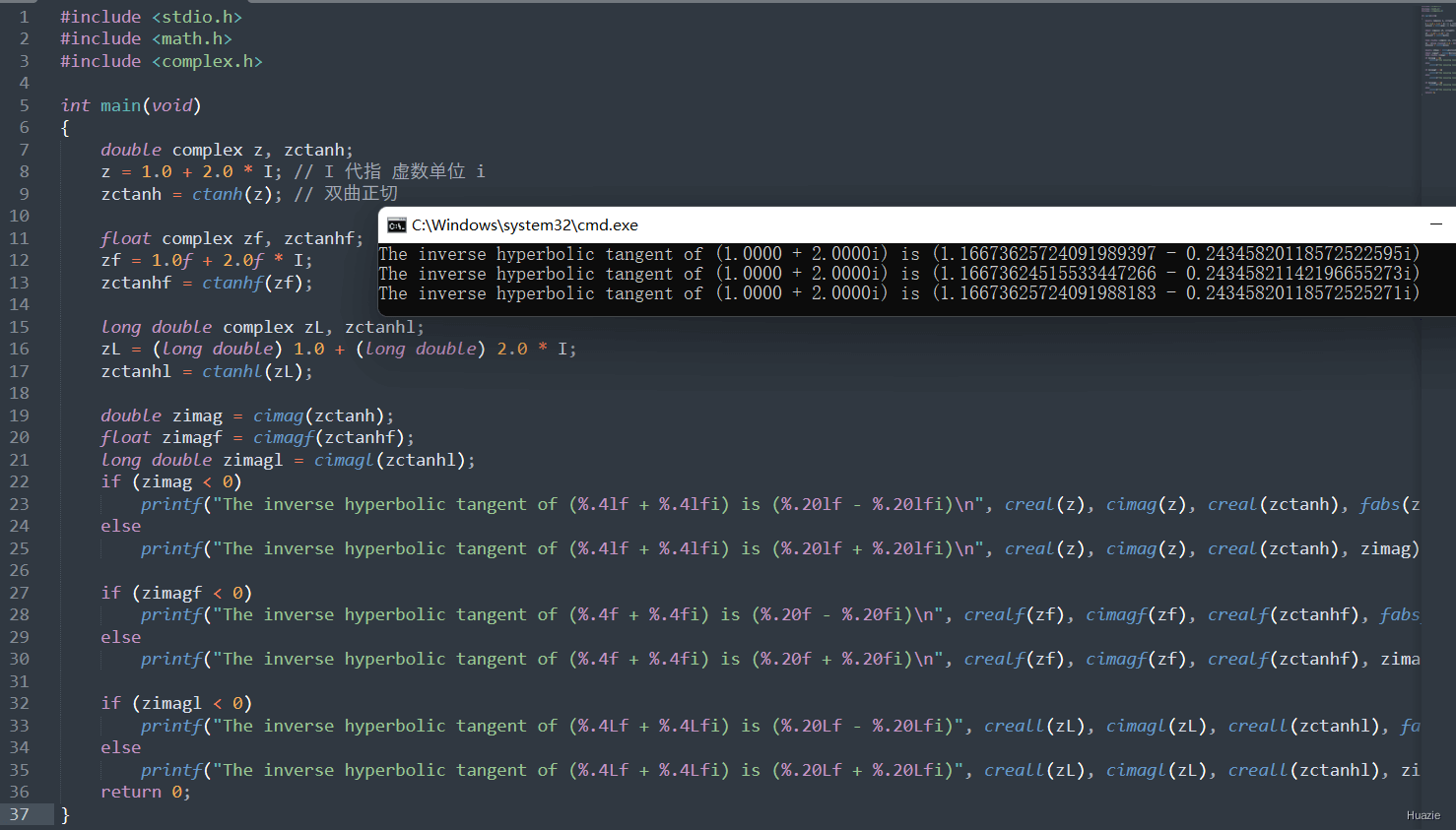
17. cexp,cexpf,cexpl
17.1 函数说明
函数声明 | 函数功能 |
|---|---|
| 计算复数z的指数基数e(double complex) |
| 计算复数z的指数基数e(float complex) |
| 计算复数z的指数基数e(long double complex) |
17.2 演示示例
#include <stdio.h>
#include <math.h>
#include <complex.h>
int main(void)
{
double complex z, zcexp;
z = 1.0 + 2.0 * I; // I 代指 虚数单位 i
zcexp = cexp(z); // 指数基数e
float complex zf, zcexpf;
zf = 1.0f + 2.0f * I;
zcexpf = cexpf(zf);
long double complex zL, zcexpl;
zL = (long double) 1.0 + (long double) 2.0 * I;
zcexpl = cexpl(zL);
double zimag = cimag(zcexp);
float zimagf = cimagf(zcexpf);
long double zimagl = cimagl(zcexpl);
if (zimag < 0)
printf("The base-e exponential of (%.4lf + %.4lfi) is (%.20lf - %.20lfi)\n", creal(z), cimag(z), creal(zcexp), fabs(zimag));
else
printf("The base-e exponential of (%.4lf + %.4lfi) is (%.20lf + %.20lfi)\n", creal(z), cimag(z), creal(zcexp), zimag);
if (zimagf < 0)
printf("The base-e exponential of (%.4f + %.4fi) is (%.20f - %.20fi)\n", crealf(zf), cimagf(zf), crealf(zcexpf), fabsf(zimagf));
else
printf("The base-e exponential of (%.4f + %.4fi) is (%.20f + %.20fi)\n", crealf(zf), cimagf(zf), crealf(zcexpf), zimagf);
if (zimagl < 0)
printf("The base-e exponential of (%.4Lf + %.4Lfi) is (%.20Lf - %.20Lfi)", creall(zL), cimagl(zL), creall(zcexpl), fabsl(zimagl));
else
printf("The base-e exponential of (%.4Lf + %.4Lfi) is (%.20Lf + %.20Lfi)", creall(zL), cimagl(zL), creall(zcexpl), zimagl);
return 0;
}17.3 运行结果

18. clog,clogf,clogl
18.1 函数说明
函数声明 | 函数功能 |
|---|---|
| 计算复数z的自然对数(以e为底)(double complex) |
| 计算复数z的自然对数(以e为底)(float complex) |
| 计算复数z的自然对数(以e为底)(long double complex) |
18.2 演示示例
#include <stdio.h>
#include <math.h>
#include <complex.h>
int main(void)
{
double complex z, zclog;
z = 1.0 + 2.0 * I; // I 代指 虚数单位 i
zclog = clog(z); // 自然对数(以e为底)
float complex zf, zclogf;
zf = 1.0f + 2.0f * I;
zclogf = clogf(zf);
long double complex zL, zclogl;
zL = (long double) 1.0 + (long double) 2.0 * I;
zclogl = clogl(zL);
double zimag = cimag(zclog);
float zimagf = cimagf(zclogf);
long double zimagl = cimagl(zclogl);
if (zimag < 0)
printf("The natural (base-e) logarithm of (%.4lf + %.4lfi) is (%.20lf - %.20lfi)\n", creal(z), cimag(z), creal(zclog), fabs(zimag));
else
printf("The natural (base-e) logarithm of (%.4lf + %.4lfi) is (%.20lf + %.20lfi)\n", creal(z), cimag(z), creal(zclog), zimag);
if (zimagf < 0)
printf("The natural (base-e) logarithm of (%.4f + %.4fi) is (%.20f - %.20fi)\n", crealf(zf), cimagf(zf), crealf(zclogf), fabsf(zimagf));
else
printf("The natural (base-e) logarithm of (%.4f + %.4fi) is (%.20f + %.20fi)\n", crealf(zf), cimagf(zf), crealf(zclogf), zimagf);
if (zimagl < 0)
printf("The natural (base-e) logarithm of (%.4Lf + %.4Lfi) is (%.20Lf - %.20Lfi)", creall(zL), cimagl(zL), creall(zclogl), fabsl(zimagl));
else
printf("The natural (base-e) logarithm of (%.4Lf + %.4Lfi) is (%.20Lf + %.20Lfi)", creall(zL), cimagl(zL), creall(zclogl), zimagl);
return 0;
}18.3 运行结果
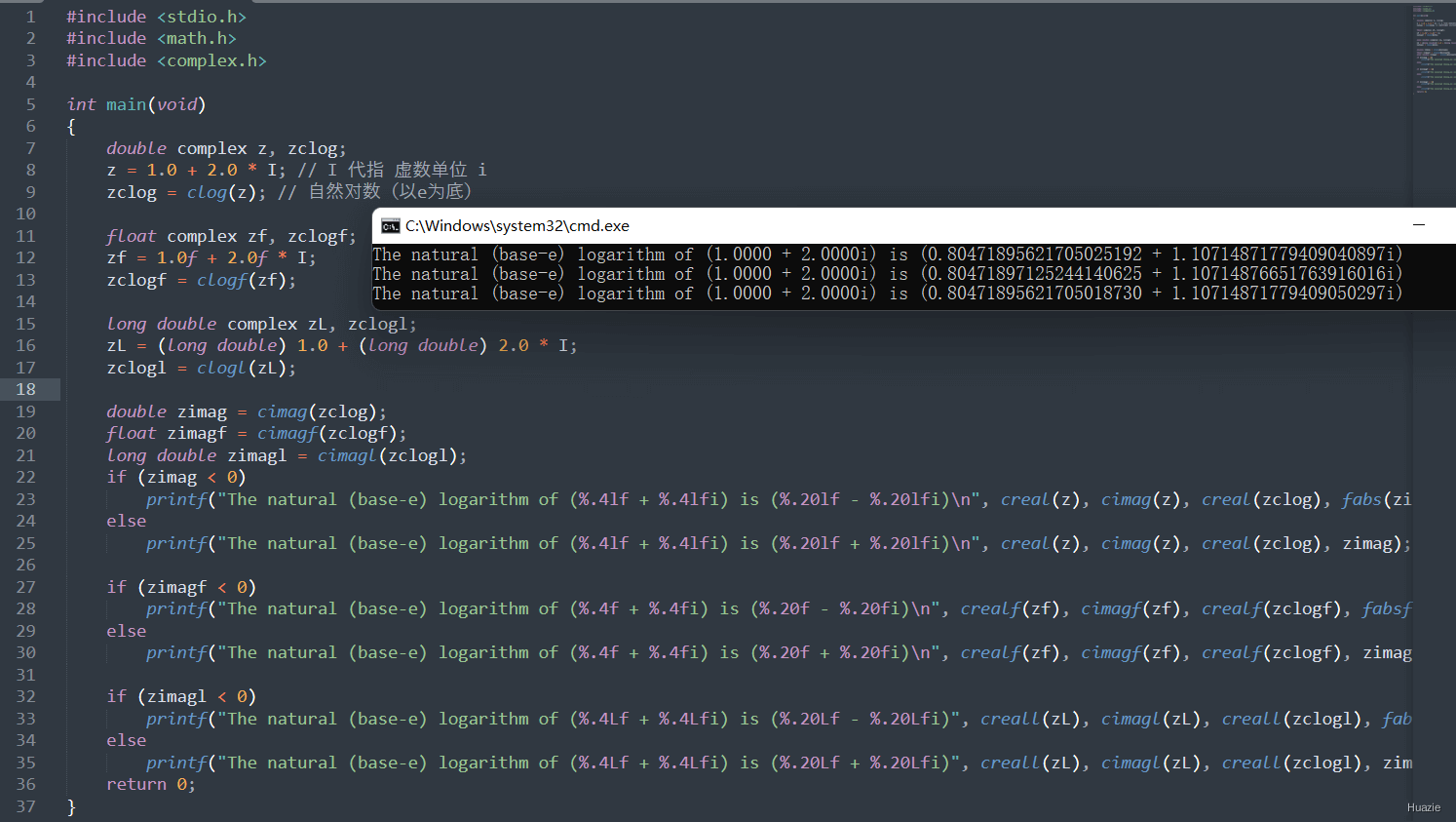
19. conj,conjf,conjl
19.1 函数说明
函数声明 | 函数功能 |
|---|---|
| 计算复数z的共轭(double complex) |
| 计算复数z的共轭(float complex) |
| 计算复数z的共轭(long double complex) |
19.2 演示示例
#include <stdio.h>
#include <math.h>
#include <complex.h>
int main(void)
{
double complex z, zconj;
z = 1.0 + 2.0 * I; // I 代指 虚数单位 i
zconj = conj(z); // 共轭
float complex zf, zconjf;
zf = 1.0f + 2.0f * I;
zconjf = conjf(zf);
long double complex zL, zconjl;
zL = (long double) 1.0 + (long double) 2.0 * I;
zconjl = conjl(zL);
double zimag = cimag(zconj);
float zimagf = cimagf(zconjf);
long double zimagl = cimagl(zconjl);
if (zimag < 0)
printf("The conjugate of (%.4lf + %.4lfi) is (%.4lf - %.4lfi)\n", creal(z), cimag(z), creal(zconj), fabs(zimag));
else
printf("The conjugate of (%.4lf + %.4lfi) is (%.4lf + %.4lfi)\n", creal(z), cimag(z), creal(zconj), zimag);
if (zimagf < 0)
printf("The conjugate of (%.4f + %.4fi) is (%.4f - %.4fi)\n", crealf(zf), cimagf(zf), crealf(zconjf), fabsf(zimagf));
else
printf("The conjugate of (%.4f + %.4fi) is (%.4f + %.4fi)\n", crealf(zf), cimagf(zf), crealf(zconjf), zimagf);
if (zimagl < 0)
printf("The conjugate of (%.4Lf + %.4Lfi) is (%.4Lf - %.4Lfi)", creall(zL), cimagl(zL), creall(zconjl), fabsl(zimagl));
else
printf("The conjugate of (%.4Lf + %.4Lfi) is (%.4Lf + %.4Lfi)", creall(zL), cimagl(zL), creall(zconjl), zimagl);
return 0;
}19.3 运行结果

20. cpow,cpowf,cpowl
20.1 函数说明
函数声明 | 函数功能 |
|---|---|
| 计算x的y次方值 (double complex) |
| 计算x的y次方值 (float complex) |
| 计算x的y次方值 (double complex) |
20.2 演示示例
#include <stdio.h>
#include <math.h>
#include <complex.h>
int main(void)
{
double complex x, y, z;
x = 1.0 + 2.0 * I; // I 代指 虚数单位 i
y = 2.0 + 1.0 * I;
z = cpow(x, y); // x的y次方值
float complex xf, yf, zf;
xf = 1.0f + 2.0f * I;
yf = 2.0f + 1.0f * I;
zf = cpowf(xf, yf);
long double complex xL, yL, zL;
xL = (long double) 1.0 + (long double) 2.0 * I;
yL = (long double) 2.0 + (long double) 1.0 * I;
zL = cpowl(xL, yL);
double zimag = cimag(z);
float zimagf = cimagf(zf);
long double zimagl = cimagl(zL);
if (zimag < 0)
printf("the value of (%.4lf + %.4lfi) raised to the (%.4lf + %.4lfi) power is (%.20lf - %.20lfi)\n",
creal(x), cimag(x), creal(y), cimag(y), creal(z), fabs(zimag));
else
printf("the value of (%.4lf + %.4lfi) raised to the (%.4lf + %.4lfi) power is (%.20lf + %.20lfi)\n",
creal(x), cimag(x), creal(y), cimag(y), creal(z), zimag);
if (zimagf < 0)
printf("the value of (%.4f + %.4fi) raised to the (%.4f + %.4fi) power is (%.20f - %.20fi)\n",
crealf(xf), cimagf(xf), crealf(yf), cimagf(yf), crealf(zf), fabs(zimagf));
else
printf("the value of (%.4f + %.4fi) raised to the (%.4f + %.4fi) power is (%.20f + %.20fi)\n",
crealf(xf), cimagf(xf), crealf(yf), cimagf(yf), crealf(zf), zimagf);
if (zimagl < 0)
printf("the value of (%.4Lf + %.4Lfi) raised to the (%.4Lf + %.4Lfi) power is (%.20Lf - %.20Lfi)\n",
creall(xL), cimagl(xL), creall(yL), cimagl(yL), creall(zL), fabs(zimagl));
else
printf("the value of (%.4Lf + %.4Lfi) raised to the (%.4Lf + %.4Lfi) power is (%.20Lf + %.20Lfi)\n",
creall(xL), cimagl(xL), creall(yL), cimagl(yL), creall(zL), zimagl);
return 0;
}20.3 运行结果
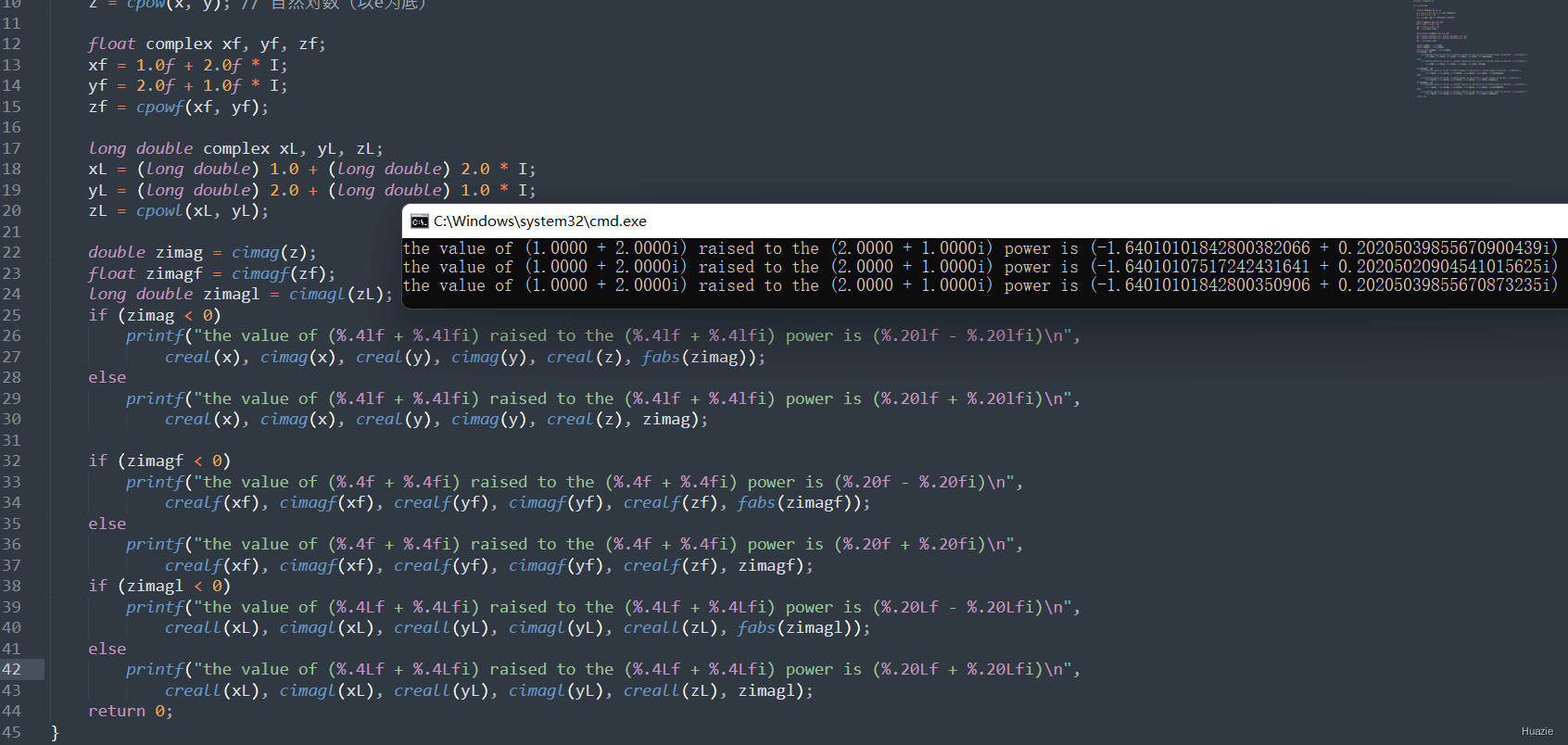
21. cproj,cprojf,cprojl
21.1 函数说明
函数声明 | 函数功能 |
|---|---|
| 计算复数z在黎曼球面上的投影(double complex) |
| 计算复数z在黎曼球面上的投影(float complex) |
| 计算复数z在黎曼球面上的投影(long double complex) |
黎曼球面上的投影是一种将三维空间中的黎曼球面与二维复平面通过立体投影方式建立一一对应关系的映射。
21.2 演示示例
#include <stdio.h>
#include <math.h>
#include <complex.h>
int main(void)
{
double complex z, zcproj;
z = 1.0 + 2.0 * I; // I 代指 虚数单位 i
zcproj = cproj(z); // 计算复数z在黎曼球面上的投影
float complex zf, zcprojf;
zf = NAN + INFINITY * I;
zcprojf = cprojf(zf);
long double complex zL, zcprojl;
zL = INFINITY + (long double) 3.0 * I;
zcprojl = cprojl(zL); // 结果相当于 INFINITY + i*copysign(0.0, cimag(z)).
double zimag = cimag(zcproj);
float zimagf = cimagf(zcprojf);
long double zimagl = cimagl(zcprojl);
if (zimag < 0)
printf("The projection of the (%.4lf + %.4lf i) onto the Riemann sphere is (%.4lf - %.4lf i)\n", creal(z), cimag(z), creal(zcproj), fabs(zimag));
else
printf("The projection of the (%.4lf + %.4lf i) onto the Riemann sphere is (%.4lf + %.4lf i)\n", creal(z), cimag(z), creal(zcproj), zimag);
if (zimagf < 0)
printf("The projection of the (%.4f + %.4f i) onto the Riemann sphere is (%.4f - %.4f i)\n", crealf(zf), cimagf(zf), crealf(zcprojf), fabsf(zimagf));
else
printf("The projection of the (%.4f + %.4f i) onto the Riemann sphere is (%.4f + %.4f i)\n", crealf(zf), cimagf(zf), crealf(zcprojf), zimagf);
if (zimagl < 0)
printf("The projection of the (%.4Lf + %.4Lf i) onto the Riemann sphere is (%.4Lf - %.4Lf i)", creall(zL), cimagl(zL), creall(zcprojl), fabsl(zimagl));
else
printf("The projection of the (%.4Lf + %.4Lf i) onto the Riemann sphere is (%.4Lf + %.4Lf i)", creall(zL), cimagl(zL), creall(zcprojl), zimagl);
return 0;
}21.3 运行结果
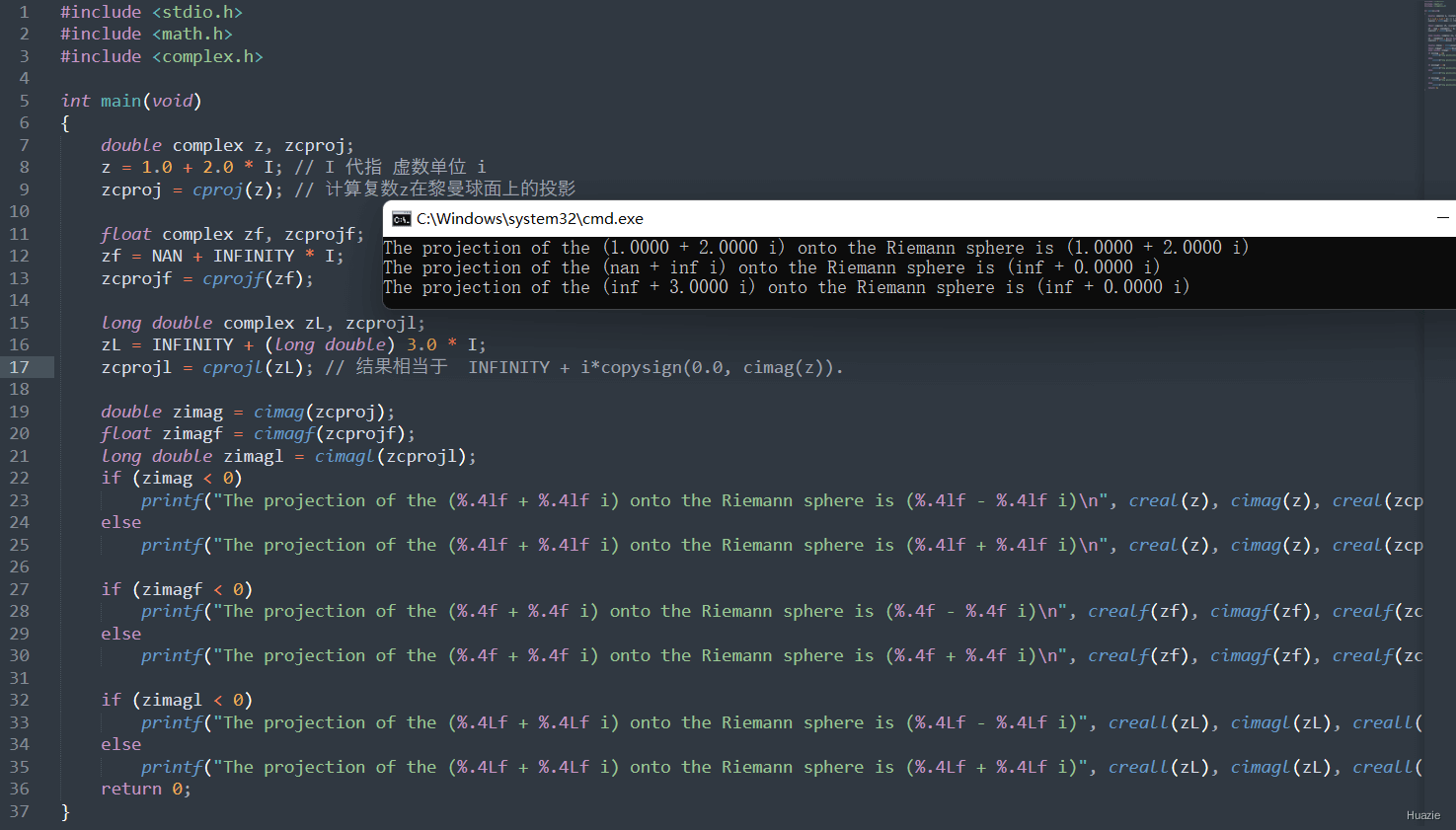
22. csqrt,csqrtf,csqrtl
22.1 函数说明
函数声明 | 函数功能 |
|---|---|
| 计算复数z的平方根(double complex) |
| 计算复数z的平方根(float complex) |
| 计算复数z的平方根(long double complex) |
22.2 演示示例
#include <stdio.h>
#include <math.h>
#include <complex.h>
int main(void)
{
double complex z, zcsqrt;
z = 9.0 + 9.0 * I; // I 代指 虚数单位 i
zcsqrt = csqrt(z); // 平方根
float complex zf, zcsqrtf;
zf = 4.0f + 4.0f * I;
zcsqrtf = csqrtf(zf);
long double complex zL, zcsqrtl;
zL = (long double) 16.0 + (long double) 16.0 * I;
zcsqrtl = csqrtl(zL);
double zimag = cimag(zcsqrt);
float zimagf = cimagf(zcsqrtf);
long double zimagl = cimagl(zcsqrtl);
if (zimag < 0)
printf("The square root of (%.4lf + %.4lfi) is (%.20lf - %.20lfi)\n", creal(z), cimag(z), creal(zcsqrt), fabs(zimag));
else
printf("The square root of (%.4lf + %.4lfi) is (%.20lf + %.20lfi)\n", creal(z), cimag(z), creal(zcsqrt), zimag);
if (zimagf < 0)
printf("The square root of (%.4f + %.4fi) is (%.20f - %.20fi)\n", crealf(zf), cimagf(zf), crealf(zcsqrtf), fabsf(zimagf));
else
printf("The square root of (%.4f + %.4fi) is (%.20f + %.20fi)\n", crealf(zf), cimagf(zf), crealf(zcsqrtf), zimagf);
if (zimagl < 0)
printf("The square root of (%.4Lf + %.4Lfi) is (%.20Lf - %.20Lfi)", creall(zL), cimagl(zL), creall(zcsqrtl), fabsl(zimagl));
else
printf("The square root of (%.4Lf + %.4Lfi) is (%.20Lf + %.20Lfi)", creall(zL), cimagl(zL), creall(zcsqrtl), zimagl);
return 0;
}22.3 运行结果
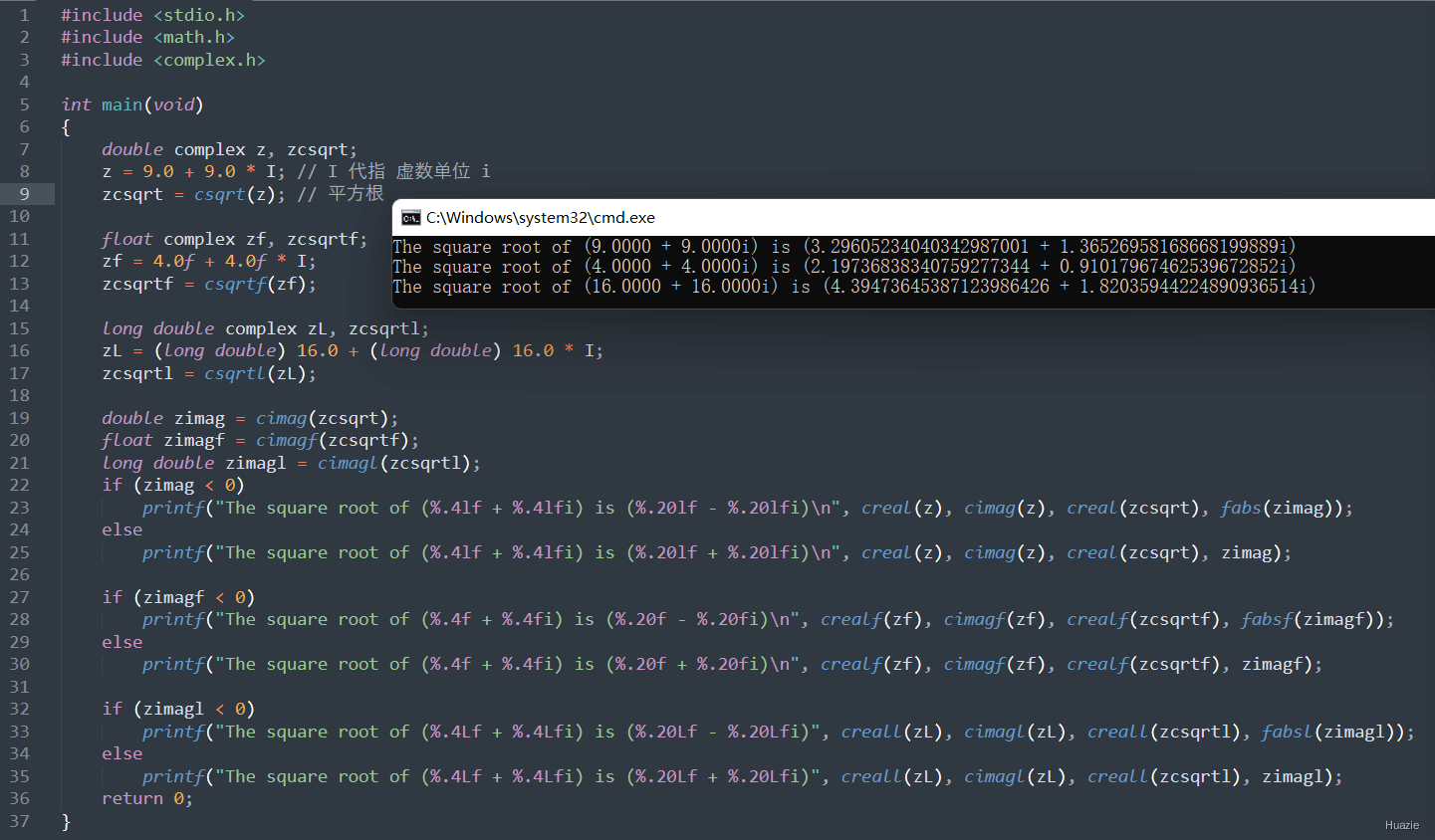
参考
原创声明:本文系作者授权腾讯云开发者社区发表,未经许可,不得转载。
如有侵权,请联系 cloudcommunity@tencent.com 删除。
原创声明:本文系作者授权腾讯云开发者社区发表,未经许可,不得转载。
如有侵权,请联系 cloudcommunity@tencent.com 删除。

